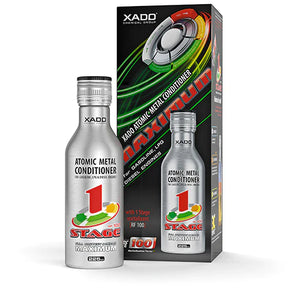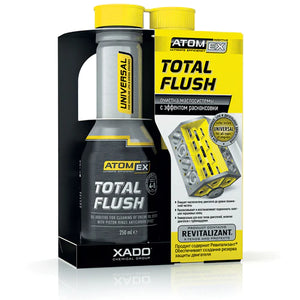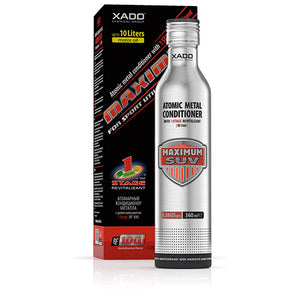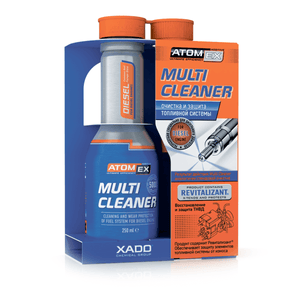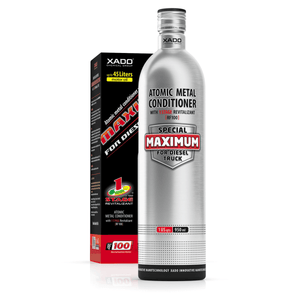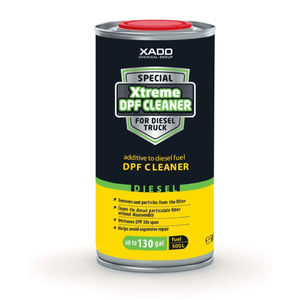DPF Cleaner Dissolves Contaminants for Your Diesel Motor
Diesel Particulate Filter (DPF) Cleaner for Your Diesel Motor
So you’ve noticed your car is using more fuel and making weird noises. Even worse, a DPF warning light has popped up on the dashboard. You now know the diesel particulate filter isn’t in great condition, but how can you go about fixing it?
When your DPF is underperforming, you have two options: buy a new filter, or clean the one you have.
If you want to avoid a costly replacement but extend the life of your current DPF, your best strategy will be professional-grade cleaning products designed specifically for diesel engine care.
Let's take a look at the most popular and effective methods for keeping the diesel particulate filter clean, functional, and optimized for long-term use.

What is a DPF?
If you drive a diesel-powered vehicle, it’s critical to understand the structure and functions of the particulate filter. As one of the most significant elements of the exhaust system, its performance impacts both the overall condition of the car and the environment around it (nobody wants to leak black smog).
Most diesel automobiles are equipped with particulate filters that trap up to 90% of polluting particles. The filter’s design consists of two parts: a metal case and an acellular ceramic matrix.
When soot and ash are blocked by the matrix, they settle in the pores of the mechanism. This process helps vehicles comply with emissions and environmental standards by preventing pollution from escaping the vehicle and entering the atmosphere.
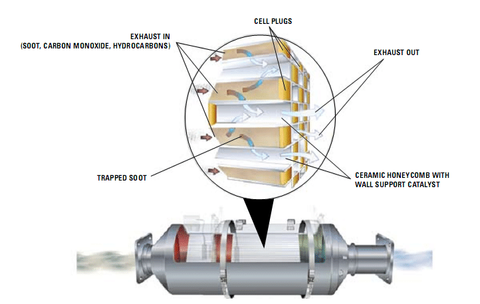
The Mechanics and Dangers Behind the DPF Pressure Sensor Differential
If DPF is experiencing a significant difference in pressure, problems will occur with the filter. This is why the DPF is equipped with two pressure sensors on either end. They are installed in the engine compartment, then connected to both the particulate filter and the electronic control unit. The sensors measure the accumulated soot amount and send notifications to the control panel if the difference in pressure is significant enough to cause issues.
Timely DPF cleanings for diesel motors maintain the filter’s performance and the keep the pressure sensor in optimal condition. If the sensor doesn't work properly, the DPF may become critically contaminated without you even knowing it. You can identify sensor failure with the following signs:
- rise in the engine and gearbox temperature
- increased fuel consumption
- reduction in engine power
- errors with codes P2452, P2453, P2454, P2455
By removing the DPF contaminants that damage the diesel particulate filter and sensors, optimal vehicle performance is easier to achieve. When the DPF regeneration process is complete, you can rest easy knowing your sensor is looking out for your filter, and in turn, your safety.
You might now be wondering how to clean the DPF? Where the best DPF cleaner is available?

DPF Regeneration: Self-Cleaning While You Drive
Most manufacturers equip vehicles with a self-cleaning procedure, so the exhaust system can clean and reset itself during what’s called the ‘regeneration phase.’ There are two types: passive DPF regeneration and active DPF regeneration. Both take place during normal vehicle operation.
Passive DPF regeneration happens when the following conditions are met:
- exhaust gas temperature exceeds 350 degrees Celsius
- the engine runs at high speeds (at least 3000 per minute)
- there is sufficient fuel in the tank (more than a quarter or preferably more than half)
Driving for short distances, traffic jams, and low speeds prevent passive regeneration from starting. Depending on the car’s condition, the filter can easily remain clogged as a result. To kickstart passive DPF regeneration, drive at high speed for at least half an hour.

Active diesel particulate filter regeneration takes place when the differential sensor detects heavy filter contamination and sends a notification to the ECU. Active DPF regeneration can take place in any driving condition.
Whether passive or active, the regeneration phase is critical for removing soot while driving.
When is the DPF Cleaner Fluid used?
The DPF filter is a limited working resource, so in some cases, neither active nor passive regeneration will help. That’s where cleaning comes in.
One of the most popular ways to clean the DPF these days is by using a DPF Cleaning Fluid. The product usually comes with a DPF cleaner bottle filled with cleaning ingredient, as well as an air gun, a probe, and a flush.
You’ll know it’s time to clean the particulate filter manually when you notice these symptoms:
- loss of engine power
- dynamic indicators deterioration
- complications starting a diesel engine
- increased fuel consumption
- strangely colored gas exiting from the exhaust pipe
- an unpleasant smell in the cabin

How a DPF cleaner is used
The first step is to double check that the root of the problem is indeed the vehicle's exhaust system. Getting it checked it by a professional is always a great idea.
If your mechanic confirms the DPF was clogged, and you’ve decided to clean the particulate filter instead of replacing it, be sure to stock up on patience – this process isn’t always a cakewalk.

And of course, don’t delay your cleaning. If a DPF warning is on, driving can be dangerous.
Now, you have a two ways to clean the DPF.
The first requires the particulate filter to be disassembled. Here’s how:
- Disconnect sensors.
- Remove mounting bolts.
- Carefully remove the pipe.
- Remove the filter.
For this method, you'll need at least 4 quarts of a petroleum-based fluids for one rinse. Next:
- Pour the liquid into the filter.
- Leave it for 8-10 hours to allow the DPF cleaner to dissolve compounds.
- Drain the liquid and rinse the filter with clean water.
- Dry the filter and install it back to its original position.

The second option requires no disassembling of the DPF. This path may be easier, but it’s only effective if you use water-alkaline liquids. You’ll need a spray gun, a wand, and of course, top-tier cleaning chemicals (for this method, never use petroleum products -- only pour alkaline liquids):
- First, disconnect the temperature and pressure sensors.
- Warm up the engine, turn off the vehicle, and wait until the filter cools down to a temperature of 40 degrees Celsius.
- Using a spray gun and a wand, inject 1 quart of cleaning liquid through the pressure sensor entrance. Leave the product in place for 15 minutes.
- Now, in order to clean DPF from alkaline, spray some water.
- Reinstall the pressure sensor of DPF.
Be careful when choosing a filter cleaner. Never use petroleum-based products unless you are using the first method. You can only use alkaline-based liquids.
To allow the regeneration process to do its thing, start the engine after cleaning and run it at high speed for at least 20 minutes. If your vehicle has an automatic transmission, the kickdown mode will also help enhance the cleaning process even further.

Finally, there’s one last method to the DPF filter without removing it: using additives for diesel fuel tanks regularly. Doing so prevents DPF pollution while protecting your exhaust system long-term.
Cleaning Your DPF With XADO
Cleaning your DPF with a DPF Cleaner Fluid is a long and hard process. It requires knowledge, patience, and hard work. At XADO, we aim to make this process as easy as possible.
That’s why our active DPF solution cleans the filter without too many extra steps. But like with any other vehicle investment, it’s important to do your research and make sure you choose the right product.
To ensure you’re using in the right solution, we suggest looking for additives produced with the XADO trademark. We manufacture some of the best-selling chemical formulas around the world to tackle a variety of auto issues, and we’ve earned this reliable reputation for a reason.
For this particular issue, we use a careful blend of combustion catalysts to remove pollutants from the DPF without dismantling it. In just a few easy steps, our DPF cleaner effectively stimulates the soot-burning process while driving.

The XADO Atomex DPF Cleaner works by…
- Passively increasing exhaust gases temperature, thus burning out soot particles.
- Kickstarting the passive regeneration process.
- Prolonging filter life.
The product is designed specifically for diesel vehicles equipped with Diesel Particulate Filters. While we have a product that serves passenger vehicles, we also have a product that works for heavier equipment with diesel engines (Detroit, Caterpillar, Mack, International, Volvo, John Deere, New Holland, etc). It’s even compatible with every type of diesel fuel and perfect for straightforward use: simply add the allotted portion to the fuel tank before filling up and repeat every 2000-3000 mi.

Whether you operate massive commercial vehicles or standard sedans, when you get ahead of filter issues with XADO additives, you avoid costly replacements and time-consuming repairs.
What’s Better: Fluid Additive or Filter Cleaning?
Before you pursue a deep clean, it’s important to make sure it’s the best option for your vehicle. Let's consider alternative ways of solving the problem.
What can you do if the diesel particulate filter is clogged?
Buying a new filter
Buying a new diesel particulate filter might make the most sense at first glance, but costs start at $2,500. It’s particularly expensive because the DPF is made from high-quality temperature-resistant ceramic containing platinum. You could look for replicated parts, but non-original spare parts wear down quickly.

DPF Removal
Car enthusiasts often fall back upon this method, but the vehicle doesn't meet environmental standards once the diesel particulate filter is removed. It’s also time-consuming, requiring:
- mechanical removal of the filter;
- reprogramming of the electronic unit;
- diagnostics
Removal is also expensive, with prices hovering around $1000. When your vehicle has problems passing the technical and environmental inspection, that price likely won’t be worth it.

Filter cleaning
That leaves filter cleaning, the ideal way to get the exhaust system back to normal performance. Even better, all you have to do is pour your XADO additive into the fuel tank. That’s it!
Let’s review some pros and cons:
|
Method |
Advantages |
Minuses |
|
Replacement |
New filter with guaranteed longevity. |
The filter costs between $2,500 and $10,000 depending on the car model. |
|
Removal |
It is cheaper than buying a new filter. The problem is solved forever. |
Still expensive. Costs at least $1,000. Laborious process. Future issues during emissions inspections Harm to the environment. Loud noise from the exhaust pipe. |
|
Purification |
Fine filtration & cleaner provide in-depth de-clogging. Minimum pressure drop & maintenance after the procedure. Low cost - 90% economics |
Cleaning should be done every 5000 km. |
XADO isn't the only company producing cleaners for particulate filters. Let’s compare the XADO DPF Cleaner with competitors' products:
|
Comparison table with competitors |
||||
|
Price |
19.90$ |
17.90$ |
18.90$ |
35.90$ |
|
Consumption |
1 bottle for 10-16 gallons of fuel |
1 bottle for 18.5 gallons of fuel |
1 bottle for 158.5 gallons of fuel |
1 bottle for 10.5 gallons of fuel |
|
Size |
250 ml |
250 ml |
475 ml |
500 ml |
|
Cleaning frequency |
2000-3000 mi |
1200 mi |
Every fill up |
1800 mi |
|
Using |
without disassembly |
without disassembly |
without disassembly |
without disassembly |
|
Start regeneration |
+ |
+ |
+ |
+ |
|
Prevention of blockages |
+ |
+ |
+ |
+ |
When you choose XADO, you get reliable protection for your car engine, easy application, and longevity – all for just a slightly higher cost point. Here are a few more reasons XADO customers love the XADO DPF Cleaner.
OUR BENEFITS:
- Suitable for filters with light and medium degrees of pollution.
- You don't have to remove the particulate filter to clean it.
- Prevents costly contamination and repairs on top of cleaning.
- It only takes a few minutes to clean.
- You can drive up to 3,000 miles between applications.
- The low cost makes self-cleaning affordable for everyone.
Without risking any harm to your car, the XADO DPF Cleaner removes soot from the particulate filter and prevents re-contamination moving forward.
Make sure you buy your original XADO products from official stores to avoid counterfeits. Shop online at XADO.US to explore:
- a wide range of professional products for cars
- affordable prices for the entire range of certified additives
- convenient payment methods
- fast delivery within the US
- advice for any issue
Have some lingering questions? Contact us for support choosing the best products for your car or commercial vehicle. We’ll help you choose the right additive to save money, time, and effort.

